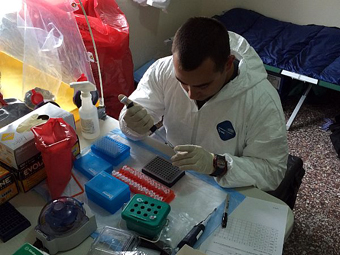
U.S. Military Assists With Fight Against Ebola
| published October 19, 2014 |
By Thursday Review staff
In this Navy photograph taken in Bushrod Island, Liberia, Lt. Jose Garcia inserts blood and tissue samples--taken from patients suffering from Ebola virus--into testing plates for analysis by doctors. Garcia is among roughly 600 U.S. military personnel currently working in four West African countries where the Ebola outbreak is at its worst. Among other assets and tools, the U.S. Navy has deployed three mobile medical testing labs to Liberia. The mobile labs, which employ two to three medical workers, can process up to 80 samples each day.
U.S. President Barack Obama has said that he intends to send as many as 4000 members of the American military to the four countries most affected by the 2014 outbreak, the worst since the virus was first identified in 1976. Though heavy rains have delayed some of the military deployments to Africa, the eventual goal is to construct 15 to 20 mid-sized treatment centers capable of maintaining up to 100 beds each. Development and construction will last until the end of November and cost roughly $750 million.
According to the World Health Organization (WHO), the 2014 outbreak of Ebola has already claimed the lives of 4,500 people since it first appeared in spring. The rate of infection spread dramatically throughout the summer, and some medical experts fear that as many as 10,000 new cases could appear each week if the current trend continues unabated. This is grim news, say some epidemiologists, who point to the most recent statistics which show a mortality rate of 70 percent for the four affected nations—Liberia, Sierra Leone, Guinea, and Nigeria.
Originally discovered and identified in Zaire (now the Democratic Republic of the Congo) in 1976, Ebola is named for the Ebola River, which flows through the village of Yambuka, where the first deadly flare-ups killed hundreds of people in a very short span of time. The disease has recurred in varying strains off and on in Africa, but never with the same high infection rate as seen this year. Though Ebola can infect humans, primates and fruit bats, it has a low mortality rate among chimpanzees, gorillas and others in the primate family. The disease is believed to have been originally spread by fruit bats, but many scientists now believe that its primary means of transport became through the unsafe handling of animal carcasses. Ebola is spread from human-to-human only through direct contact with bodily fluids—broken skin, secretions, saliva, blood, semen.
This photograph was taken by U.S. Navy Chief Petty Officer Jerrold Diederich.
Related Thursday Review articles:
In Africa, Hotel Workers Get Ebola Training; Thursday Review staff; Thursday Review; September 12, 2014.
Ebola May Place Entire Countries in Quarantine; R. Alan Clanton; Thursday Review; September 7, 2014.
